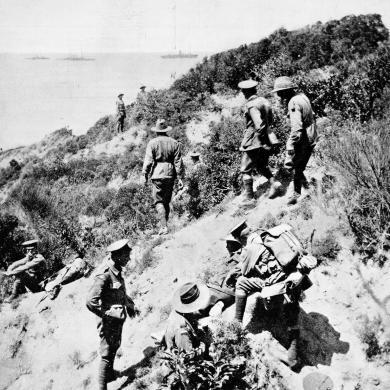Private Robert Steele's image from Gaba Tepe – published in the Auckland Weekly News on 24 June 1915 – gave the New Zealand public their first glimpse of the Gallipoli Campaign.

Detail from Private Robert Steele's photograph from Gaba Tepe. Sir George Grey Special Collections, Auckland Libraries.
This photograph below from the Auckland Weekly News Supplement (AWNS) depicts first aid being applied to an ANZAC soldier on the sloping terrain of Gaba Tepe on the Gallipoli Peninsula on 25 April 1915. Published almost two months later, on 24 June 1915, it is considered the first newspaper image of the Gallipoli campaign and is attributed to Private Robert Blackwood Steele of the Auckland Infantry Battalion. Steele himself was injured later that first day of the campaign, but continued to take photos from his perspective during his convalescence. Many of these images, as well as some that were taken before when he was stationed in Cairo, were published in the AWNS and may now be found on Auckland Libraries' Heritage Images database.
This image circulated widely, later appearing in the Illustrated London News, where it was credited to the Star Photo Studio Cairo, and the Sydney Mail where it was credited to a Sydney Quartermaster Sergeant and the subjects of the photo were supposed to be Australian. However, from variety of uniforms shows that it most likely depicts a mix of Australians and New Zealanders.
'New Zealanders in action: a remarkable photograph taken under fire at the Dardanelles, showing signallers rendering first aid to a fallen comrade and transports in the distance', 1915. Photograph taken by R. B. Steele, and published in the Auckland Weekly News. Sir George Grey Special Collections, Auckland Libraries, AWNS-19150624-35-1.
Full length portrait of Private Steele, 1916. Photogapher: Herman Schmidt. Sir George Grey Special Collections, Auckland Libraries, 31-S1141.
War photography had occurred since at least the Crimean War (1853-1855), but by the time of the First World War, changes in lenses and the invention of celluloid film made photography faster and more portable than ever. No longer did photographers need to transport unwieldy glass plates and chests of chemicals to war zones; compact camera equipment of the kind pictured below was accessible to the average soldier. Officially, cameras were not allowed to be taken to the front line for security reasons. In reality, cameras such as the Vest Pocket Kodak, which debuted in April 1912, were by 1914 so popular with soldiers that they were being marketed as ‘The Soldier’s Camera’.
A portable folding camera from the early 1900s, similar to the ones used by many soldiers at Gallipoli. Image courtesy of Te Papa (TP000037), CC BY-NC-ND licence.
This advertisement from the Auckland Star, published on 20 September 1915, descibes the camera as a 'Soldier's Kodak' - showing a disregard for official military restrictions on frontline photography. Image sourced from PapersPast.
The many photographs these soldiers took became important records of the experience of war, not least because the New Zealand government did not appoint an official war photographer until March 1917, when Henry Armytage Sanders was engaged to document the Western Front. A few weeks later Thomas Frederick Scales was appointed as Cinema Expert for New Zealand Units in England. Read more about New Zealand's official First World War photography.
Incentives were offered for soldiers to submit their photographs for publication. In the advertisement below, Harrington’s of Wellington promotes their cameras by mentioning the prices that newspapers were willing to pay for soldiers' photographs.
Harrington's of Wellington used the lure of monetary rewards given for war photos published in prominent newspapers to sell their cameras. Image sourced from PapersPast.